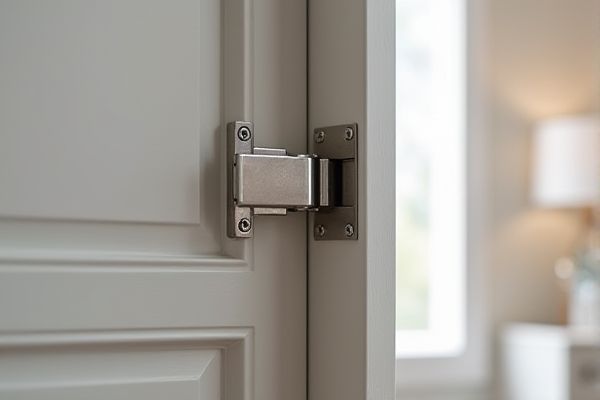
Euro hinges provide a sleek, external adjustment feature ideal for easy door alignment, while concealed hinges offer a completely hidden mechanism for a cleaner cabinet appearance and enhanced security. Explore the rest of the article to discover which hinge type best suits your cabinetry needs and style preferences.
Table of Comparison
| Feature | Euro Hinge | Concealed Hinge |
|---|---|---|
| Definition | Type of concealed hinge with a cup mounted inside door, popular in European cabinetry. | General term for hinges hidden from external view when door is closed. |
| Visibility | Completely hidden when door is closed. | Completely hidden when door is closed. |
| Installation | Requires drilling a cup hole in door, mounts on cabinet frame inside. | Various installation methods depending on hinge type, may not require cup hole. |
| Adjustability | 3-way adjustment (height, depth, side) for perfect alignment. | Adjustability varies; many offer multi-directional adjustment. |
| Applications | Common in kitchen cabinets, wardrobes, and furniture doors. | Used in diverse cabinetry and furniture for clean aesthetics. |
| Durability | Robust metal construction, designed for frequent use. | Durability varies by model but generally sturdy for cabinetry. |
| Cost | Generally affordable with widespread availability. | Price ranges from budget to premium depending on design and brand. |
Introduction to Cabinet Hinges
Euro hinges and concealed hinges are crucial components in modern cabinetry, providing smooth door operation and aesthetic appeal by remaining hidden when the cabinet door is closed. Euro hinges typically offer adjustable features for precise alignment, while concealed hinges prioritize a clean exterior look without visible hardware. Understanding the differences helps you select the best hinge type for durability, ease of installation, and design preferences.
What is a Euro Hinge?
A Euro hinge, also known as a concealed hinge, is a type of cabinet hinge commonly used in modern cabinetry for its hidden installation and adjustable features. This hinge mounts inside the cabinet, providing a clean exterior look while allowing your doors to open smoothly with precise alignment. Its design supports easy installation and multiple adjustment points, optimizing functionality and aesthetic appeal in kitchen and furniture applications.
What is a Concealed Hinge?
A concealed hinge, also known as a European hinge, is a type of cabinet hinge mounted inside the door and frame, making it invisible from the outside when the door is closed. This hinge offers adjustable settings for depth, height, and side-to-side alignment, ensuring precise door positioning and a clean, modern appearance. Its design improves cabinet aesthetics and functionality by allowing smooth, silent operation and easy installation without visible screws.
Key Differences Between Euro and Concealed Hinges
Euro hinges, commonly used in European-style cabinetry, feature an adjustable cup that mounts on the inside of the door, providing a sleek, flush exterior with your cabinets. Concealed hinges, while also hidden from view when the door is closed, vary in design and can include soft-close mechanisms for smoother operation and noise reduction. Your choice between these hinges depends on the level of adjustability, installation type, and aesthetic preference for a seamless cabinet appearance.
Installation Process: Euro Hinge vs Concealed Hinge
The installation process of a Euro hinge involves drilling a 35mm cup hole into the cabinet door, allowing for easy mounting and adjustable screws for fine-tuning alignment. Concealed hinges, while similar, often require precise mortising into the door and frame, making installation more intricate and time-consuming. Your choice depends on whether you prioritize a streamlined, less invasive installation (Euro hinge) or a more custom fit with concealed hinges.
Aesthetics and Design Considerations
Euro hinges offer a sleek, minimalist appearance ideal for modern cabinetry, as they remain hidden when the door is closed, enhancing clean lines and smooth surface aesthetics. Concealed hinges also provide a hidden mechanism but can vary in design, slightly affecting the door's alignment and overall look. Choosing between Euro and concealed hinges depends on desired aesthetics, door thickness, and ease of adjustment for maintaining a seamless design.
Durability and Performance Comparison
Euro hinges offer robust durability with a design that evenly distributes stress, making them highly resistant to wear and deformation over time. Concealed hinges, while providing a sleek aesthetic by being hidden when doors are closed, may vary in durability depending on materials and construction quality, sometimes leading to quicker wear under heavy use. Performance-wise, Euro hinges typically allow for easy adjustments and consistent door alignment, ensuring long-term functionality and smooth operation compared to some concealed hinge models.
Cost Analysis: Which is More Budget-Friendly?
Euro hinges typically offer a more budget-friendly option compared to concealed hinges due to their simpler design and widespread availability, with prices often ranging from $2 to $5 per hinge. Concealed hinges, known for their sleek, hidden appearance and advanced functionality, usually come at a higher cost, averaging between $5 and $15 per hinge. Factoring in installation complexity, Euro hinges require less labor, reducing overall expenses, while concealed hinges may increase costs due to precise alignment and mounting requirements.
Best Applications for Each Hinge Type
Euro hinges are best suited for frameless cabinets, offering smooth, adjustable functionality for modern kitchen designs and custom cabinetry. Concealed hinges work effectively in framed cabinets, providing a clean exterior look while ensuring door alignment and durability. Your choice depends on the cabinet construction and desired aesthetic, with Euro hinges excelling in flexibility and concealed hinges in structural support.
Conclusion: Choosing the Right Hinge for Your Project
Choosing the right hinge depends on the specific application and aesthetic requirements of your project. Euro hinges offer superior adjustability and a sleek, concealed design suitable for modern cabinetry, while concealed hinges provide a fully hidden mechanism ideal for clean, uninterrupted surfaces. Evaluating factors such as door weight, ease of installation, and desired functionality ensures the best hinge selection for durability and appearance.
 homyna.com
homyna.com